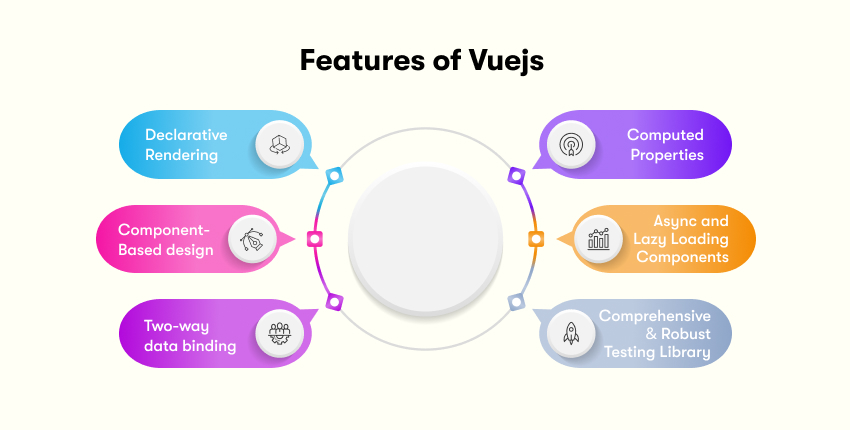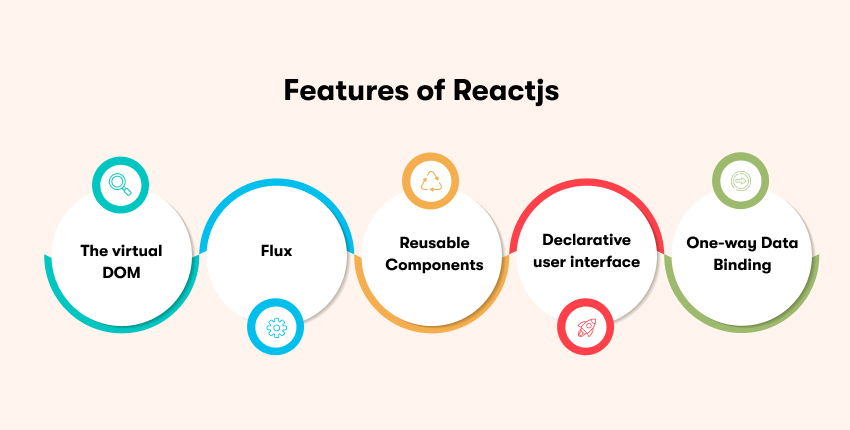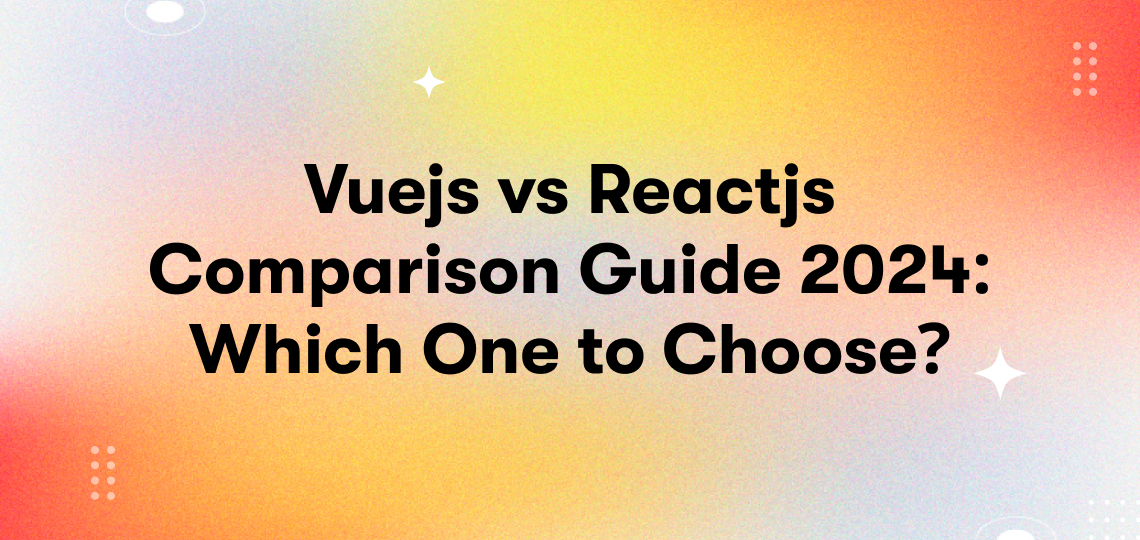Selecting the appropriate framework for a web development project can be one of the hardest things a developer has to do. With so many frameworks and languages available, making an educated pick is critical.
While we’re discussing technologies and development frameworks, Vue vs React are two of the most popular JavaScript technologies for web development, and for good reason. Both provide developers with flexibility, significant tools to work with, and robust development communities for support.
However, each of them has unique strengths and limitations. So, how do you determine whether to utilize Vue vs React for a particular project?
Don’t worry, we have got you covered. In this article, we’ll be covering the basics of reactjs vs Vuejs, their features, and the key differences to make an informed decision.
What is Reactjs?
React, often referred to as a framework, is an open-source UI development JavaScript library created by Facebook in 2013. It is maintained by React’s core team along with contributions from the open-source community.
As per the StackOverflow survey 2024, React.js was the second most popular web framework & technology with 39.5% of votes.
As one of the most widely used libraries in web development, React is primarily used for building the front end of websites and applications. It leverages JSX (JavaScript Syntax Extension) to create fast, interactive, and dynamic applications by breaking the UI into reusable components.
On GitHub, React has over 1,645 contributors and more than 228K stars, reflecting its popularity among developers. Apart from Facebook and Instagram, major platforms like Codecademy, Netflix, the New York Times, and Yahoo! Mail also rely on ReactJS for their front-end development needs.
What is Vuejs?

Vue.js is an open-source, progressive, MVVM-based, accessible, highly efficient, and adaptable frontend JavaScript framework that is widely used to create user interfaces and single-page applications (SPAs).
Vue Js was released in 2014 and quickly garnered popularity among developers around the world because of its simple and short learning curve. As per the stack overflow survey 2024, Vuejs stands at number 8 among the web framework and technologies list with 15.4% of votes.
The inspiration for the development of Vue.Js originated from another JavaScript framework, Angular. Additionally, its visual components, high degree of customizable modules, and decoupled nature allow developers to expand web app functionality as needed.
Some of the well-known companies that use VueJS include BuzzFeed, EuroNews, GitLab, Grammarly, Nintendo, and Trustpilot.
- Declarative Rendering: Vue uses the declarative method to control the Document Object Model (DOM). This implies that Vue handles the necessary underlying manipulations, and developers just need to specify how they want the user interface to look.
- Component-Based design: Vue facilitates component-based design, which divides huge elements into modular and reusable parts to enable developers to create them. Every component has its own style, template, and business logic.
- Two-way data binding: As part of its MVVM framework, Vue supports two-way binding. This functionality lets you apply classes, change the style, and edit or apply values to HTML components using a binding directive.
- Computed Properties: One of the most popular features in Vue.js is a computed property. A calculated property allows you to construct properties that can be updated, edited, and displayed in an efficient and readable manner.
- Async and Lazy Loading Components: One of the greatest performance tricks for Vue.js is lazy loading, which reduces the file size, HTTP request-response time, and other issues by adding and rendering components asynchronously or on-demand.
- Comprehensive & Robust Testing Library: Vue.js has a comprehensive testing library, allowing for easy unit and end-to-end testing with minimal configuration required.
Features of Reactjs

- The virtual DOM: This React functionality helps to make the application development process more agile and faster. The technique facilitates the process of recreating a webpage within React’s virtual memory. This reduces the time and cost required to develop something.
- Flux: It is a JavaScript app design component that lets you control the flow of data from a specific point. It increases the software’s adaptability and usefulness by giving developers more control over it.
- Reusable Components: React.js is composed of several components, each of which has its own logic and controls and is in charge of carrying out brief, reusable HTML code segments. So, you can easily build and manage your web application by using its components anywhere you need to. You can even use nested components to develop more complicated apps.
- Declarative user interface: The declarative UI feature makes React code easier to read and makes addressing bugs easier. React JS is the best framework for developing dynamic and interactive user interfaces for both Internet and mobile applications.
- One-way Data Binding: As the name suggests, one-way data binding is a one-way flow. React only allows data to flow in one direction: from parent components to child components, or from top to bottom.
React vs Vue comparison: The Major Differences!
| Feature | Vue.js | React.js |
|---|---|---|
| Developed By | Created by Evan You in 2014; maintained by Evan and the open-source community. | Developed by Facebook (now Meta) in 2013; actively maintained by Facebook and the open-source community. |
| Language | Uses HTML-based templates with embedded JavaScript logic, easy for developers familiar with HTML. | Uses JSX (JavaScript + XML), allowing HTML and JavaScript to coexist; can feel unfamiliar initially. |
| Learning Curve | Easier for beginners with simpler state management; requires less setup and configuration. | Steeper learning curve due to JSX syntax and complex state management (e.g., Redux); needs understanding of the React ecosystem. |
| Architecture | Follows the MVVM (Model-View-ViewModel) pattern, effectively separating logic and UI layer. | Relies on a component-based architecture, promoting code reusability and maintainability. |
| Performance | Excellent performance for most applications; two-way data binding may impact performance in larger projects. | Utilizes a Virtual DOM for efficient updates, highly performant for large, dynamic applications. |
| Community Support | Smaller but rapidly growing community, strong support in China and Asia; ecosystem still expanding. | Larger, more mature community, making it easier to find tutorials, libraries, and support worldwide. |
| Ease of Integration | Easier to integrate with existing applications; works well alongside other libraries or frameworks. | Flexible but often used as a base for developing entire applications; slightly harder to integrate into existing codebases. |
| Flexibility | Provides official tools like Vue Router and Vuex for routing and state management, simplifying setup. | Relies on third-party tools for state management (Redux) and routing (React Router), giving more control but requiring additional setup. |
| Use Cases | Best for small to medium-sized projects, quick prototypes, and dashboards where simplicity matters. | Better suited for large-scale, complex applications where performance, modularity, and flexibility are critical. |
| Mobile Development | Offers Vue Native for cross-platform mobile application development. | React Native is more popular and widely used for developing mobile apps across iOS and Android. |
| Documentation | Clear, beginner-friendly, and well-structured documentation, easy for newcomers to get started. | Detailed and comprehensive documentation; developers need some background knowledge to fully grasp it. |
Vue vs React 2024: Which one is Better?
React, Vue, and any other JavaScript-based method are all excellent for their own use cases. There is no obvious winner in this situation. You’ll want to determine your use case and then match it to the features of these platforms.
React is a proven leader with corporate backing and a big open-source community. It is scalable, allowing you to build more complex enterprise applications.
Vue is a rapidly expanding front-end developer platform. It is a lightweight framework, making it ideal for small-scale applications. The core team has expanded Vue’s built-in features and partner libraries. This makes the development process simpler and more efficient.
If you are looking for professional assistance to help you choose between React vs Vue or you are looking for a leading development partner – then Enstacked have got you covered. Book a free consultation with our team & help you get started.
Frequently Asked Questions(FAQs)
Is Angular a better option than React vs Vue?
Angular may be a viable substitute in between React vs Vue, but it will depend on the nature of your project. However, when questioned, the majority of developers advise choosing React because of its strong app performance, extensive open-source community, thorough documentation, scalability, flexibility, and numerous other factors.
When to choose Vuejs?
Choose Vue if:
Choose Vue if:
- you need to work on a quick, smaller project that you want to learn how to do quickly.
- planning to develop progressive web apps and single-page applications.
- You would like to increase the functionalities of the current app.
When to choose Reactjs?
You can choose Reactjs:
You can choose Reactjs:
- if you need access to a wide range of tools and libraries for your project.
- thinking of building a huge, sophisticated app with a shorter time to market is necessary.
- You would like to develop an app with beautiful components and high responsiveness
How much does Reactjs development cost?
The cost of ReactJS development varies based on project complexity, developer location, and expertise. Simple applications can cost between $3,000 – $10,000, moderate apps range from $10,000 – $50,000, while complex solutions can exceed $50,000 – $150,000. Hourly rates also differ by region, with developers in North America or Europe charging $50 – $150/hour, and India or Southeast Asia offering rates between $20 – $50/hour.
Is Vuejs SEO-friendly?
VueJS isn’t inherently SEO-friendly due to its reliance on client-side rendering (CSR), which can make it difficult for search engines to index dynamic content. However, tools like Nuxt.js enable server-side rendering (SSR), significantly improving SEO. Additionally, pre-rendering static pages, managing meta tags with vue-meta, and properly handling lazy-loaded content can optimize VueJS applications for better search engine visibility.


